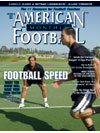AMERICAN FOOTBALL MONTHLY THE #1 RESOURCE FOR FOOTBALL COACHES
Article CategoriesAFM Magazine
|
Setting Up the Pass with the Run in the Veer Option\'The option offense gives you an advantage right off the bat. You get as much speed on the field as you possibly can.\'by: Mike Kuchar © More from this issue When you think of running the option, you think of dominant programs that have run that offense: Navy under Paul Johnson, the Air Force Academy under Fisher DeBerry, and Georgia Southern under three different offensive option gurus: Erk Russell, Johnson, and most recently, Mike Sewak. Having been mentored by both Russell and Johnson, Sewak was OC under Johnson and then head coach at GSU for four years. Since leaving Georgia Southern in 2005, Sewak has served as an option consultant � authoring countless magazine articles and producing several coaching videos on the scheme. Sewak is first to tell you that the effectiveness of the option is not accounting for unblocked defenders at the point of attack, which is why defenses are forced to put as many numbers in the tackle box as possible. It opens up tremendous potential in the vee....The full article can only be seen by subscribers. Subscribe today!
|
|
|||||||
| HOME |
MAGAZINE |
SUBSCRIBE | ONLINE COLUMNISTS | COACHING VIDEOS |
Copyright 2025, AmericanFootballMonthly.com
All Rights Reserved





